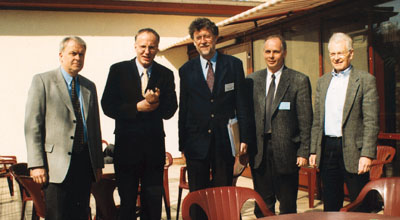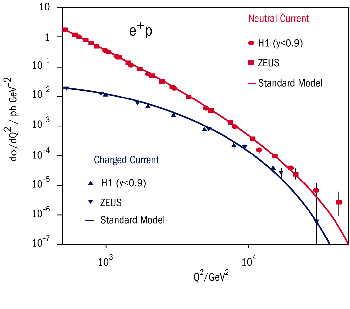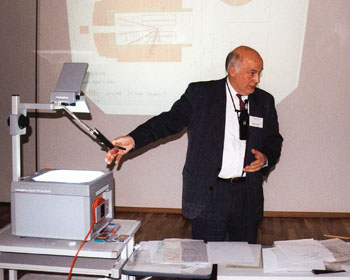The quest goes on to try to pin down the detailed inner structure of the proton. The problem is that, the harder physicists look, the more structure they find.

In the late 1960s, when experimentalists using electron beams at SLAC, Stanford, discovered that the proton contained tiny scattering centres, a new type of physics opened up: deep inelastic scattering (DIS). Ever since, physicists have tried to peer deeper and deeper into the depths of the proton. The work of the HERA electronproton collider at DESY, Hamburg, was to probe this inner proton structure in more detail than had ever been done before.
This is one of the great success stories of HERA. However, to capitalize on this new window on the proton also calls for intense study and coordinated effort. After the advent of HERA, about seven years ago, a series of specialized workshops began.
Scattering involving the constituent “partons” hidden inside the proton is the natural scenario for quantum chromodynamics (QCD), which is the field theory of the constituent quarks and gluons. DIS99 (the seventh DIS conference) was hosted by DESY Zeuthen, south of Berlin, earlier this year.
New results from the HERA collider experiments were summarized by Bernd Löhr (DESY) for ZEUS and by Tancredi Carli (Munich) for H1. Cecilia Gerber (Fermilab) reported on the Tevatron experiments and Roland Windmolders (Mons) reviewed spin physics results. Recent developments in QCD were summarized by Willy van Neerven (Leiden). Two days of parallel sessions focused on structure functions, diffraction, final states and spin physics.
The working group on structure functions was conducted by Ursula Bassler (Paris), Eric Laenen (NIKHEF), Arnulf Quadt (CERN) and Heidi Schellman (Northwestern).
Structure functions
HERA probes low x, which is the momentum fraction carried by the struck quark, down to about 10-6. New precision is accompanied by impressive theoretical work on the gluon dynamics in this domain and on the transition between the deep inelastic and the photoproduction regimes.

Standard perturbative QCD field theory has no apparent difficulties in accounting for the behaviour of the proton structure down to surprisingly low values of x and of momentum transfers (Q2). Efforts are under way to extend QCD calculations, covering the “next to next to leading order”. This is a challenging task, which will substantially reduce the theoretical uncertainties.
The emerging role of HERA as a machine for precision tests of QCD is comparable to that of CERN’s LEP electronpositron collider for testing the electroweak theory. With increasing HERA collision rates, the data at large Q2 approach the region where proton structure is probed by the W and Z weak bosons and the gluon and quark distributions become measurable even at large x, where uncertainties are currently still sizable.
The puzzling excess of high Q2 events at large x, which were first observed by H1 and ZEUS in 1997, was reported to be reduced after more data had been accumulated. The many new results from various sectors led Heidi Schellman to conclude that the “rest of the world keeps up with DESY”.
Diffractive interactions
The working group on diffractive interactions was organized by Mike Albrow (Fermilab), Riccardo Brugnera (Padova), Markus Diehl (DESY) and Douglas Jansen (Heidelberg). One early observation at HERA was that about 10% of electronproton events have little to show in the forward, proton direction. The electron interacts with something accompanying the proton rather than the proton itself. This stimulated the revival of interest in “diffractive” scattering.
Impressive new data should lead to a better understanding of this diffractive deep inelastic and photoproduction scattering. Theoretical work showed that the diffractive electronproton interaction, as for other hard-scattering processes, factorizes into a convolution of a parton distribution with an elementary scattering process. In hard hadronhadron processes, however, additional soft interactions between the two initial hadrons can occur. Such interactions are expected to suppress the diffractive effects. This may explain the apparent differences between the HERA and Tevatron (protonantiproton) measurements. Successful attempts were reported to implement diffractively produced string topologies into the simulation of the electronproton interaction final state.
The session on hadronic final states was another example of the fruitful collaboration between the HERA, LEP and Tevatron experiments. The session was coordinated by Marcello Cacciari (CERN), Frank Chlebana (Fermilab), Laurel Sinclair (Glasgow) and Mark Weber (Heidelberg). Deep inelastic processes producing two narrowly confined sprays of particles (“dijets”) were used to determine the gluon distribution at large x by the H1 experiment and the quarkgluon interaction coupling constant by the ZEUS experiment. Inclusive jet production at the Tevatron provided a new determination of this quantity, comparable to previous fits of deep inelastic scattering structure.
Dijet production also reflects the quarkgluon structure of the photon, and LEP and HERA data were presented on the gluon content of the photon. Some photon distribution parametrizations require revision owing to new measurements of the virtual photon structure. Isolated leptons with high transverse energy, observed by H1, so far have no conclusive interpretation. Theoretical and simulation work focused on the low x region and the description of gluon emission.
Spin physics
The parallel session on spin physics was organized by Michael Düren (Erlangen) and Werner Vogelsang (Stony Brook). Among new experimental results was the first indication of a positive gluon polarization, obtained from unlike charged pairs of hadrons produced at large momentum transfer, and the unexpected observation of a spin asymmetry in rho-meson production by the new HERMES experiment at HERA.
Data from SLAC (Stanford), CERN and DESY experiments determined the spin structure function. Its behaviour is in agreement with QCD. These measurements, as well as results from SMC and HERMES, allow the polarized up and down quark distributions to be determined accurately at larger x. However, the polarized gluon distribution is not yet known and the unaccountability of the proton spin in terms of its constituents the “spin crisis” remains. Its resolution will require data from the upgraded HERMES experiment and from the next generation of polarization experiments COMPASS at CERN and STAR/PHENIX at the polarized RHIC collider in order to disentangle the quark and the gluon contributions to the proton spin.
The future of DIS
A special session looked at the future of deep inelastic scattering. The first presentation, by Jorge Morfin (Fermilab), reported Fermilab’s plans for future neutrino experiments using the NuMI beam, and studies of neutrino beams from a muon collider. Dietrich von Harrach (Mainz) explained how spin physics could be extended to low x and high Q2 as well as to the polarized photon structure by accelerating polarized protons in HERA. Another future HERA option, as emphasized by Mark Strikman (DESY/Pennsylvania state), is the acceleration of nuclei in order to study electronneutron scattering in the HERA kinematic range, as well as other nuclear phenomena using heavy nuclei, which cannot be accessed with the currently attainable beam energies in electronproton collisions.

To mark DIS99, HERA ran at the record luminosity of two inverse picobarns per week. Albrecht Wagner (DESY) reported on the preparations to quadruple HERA’s luminosity during next year’s shutdown and presented DESY’s showcase TESLA, a superconducting linear electronpositron accelerator in the 500 GeV to 1 TeV range, which could be combined with an X-ray free-electron laser. Wagner and Yves Sirois (Paris) pointed out that TESLA could also be used to collide electrons of up to 500 GeV with protons in HERA of nearly 1 TeV, which would allow the inner structure to be explored down to 2 x 10-19 m. DESY has initiated a study of this option in the TESLA technical design report.
Erwin Gabathuler (Liverpool) summarized the workshop. The low x behaviour, which is measured with increasing precision by the HERA experiments, is essential in understanding what happens at high gluon densities, and also to predict reliably what will happen to CERN’s LHC interaction rates. Increasing precision leads to crucial tests of QCD, including unexplained events at extremely high Q2 and transverse energy. Machine and detector upgrades lead HERA into the next millennium with a challenging mid-term programme to use electroweak interactions for probing the nucleon structure. The next DIS conference will take place in Liverpool next April.
The proceedings of DIS99 are dedicated to the memory of DESY director Bjoern Wiik, who died in February. His outstanding personality and scientific achievements were recalled by Aharon Levy (Tel Aviv), chairman of the workshop’s international advisory committee, and Brandenburg minister of culture and research Steffen Reiche, who underlined the importance of realizing Bjoern Wiik’s vision, which led to the creation of HERA and has shaped, so decisively, the plans for TESLA.








